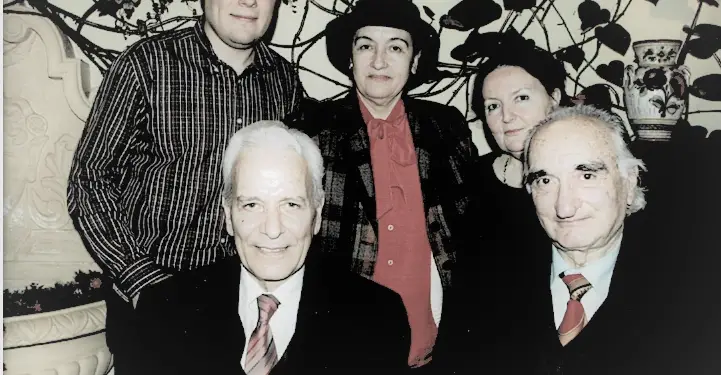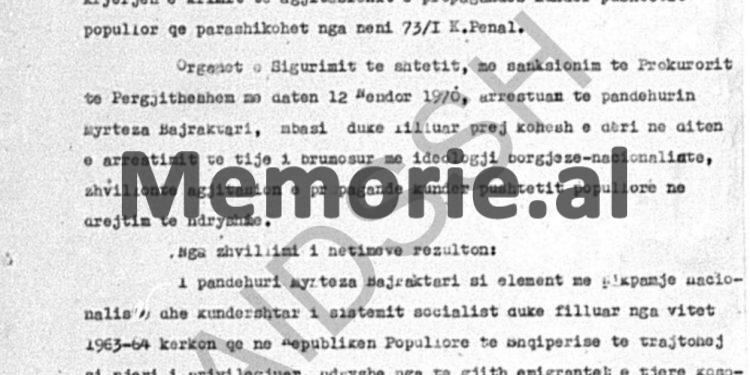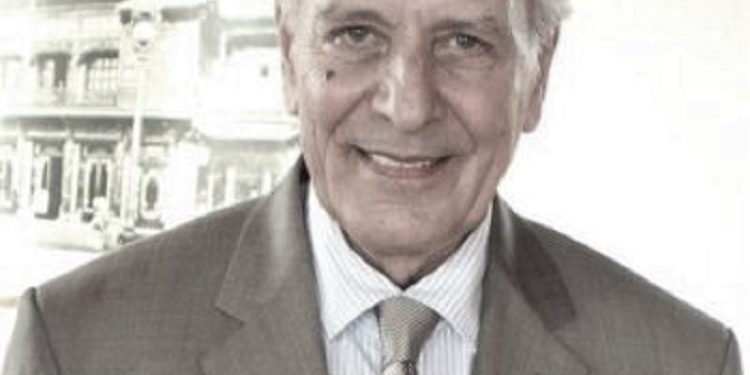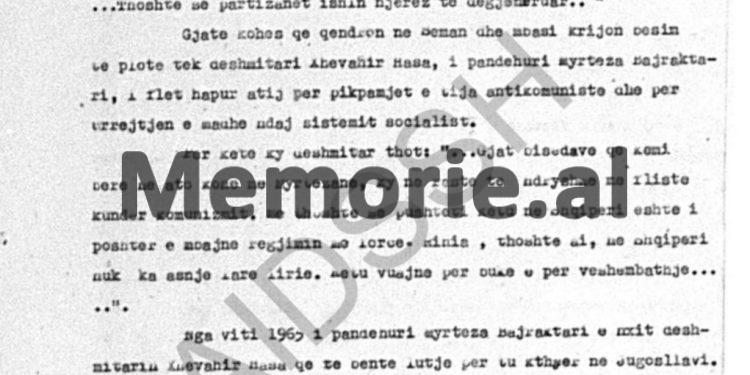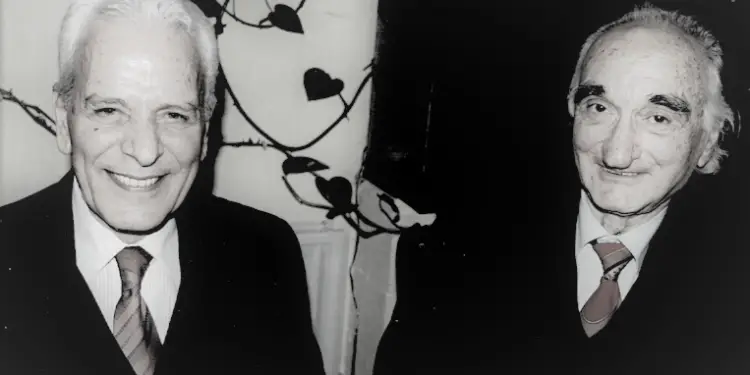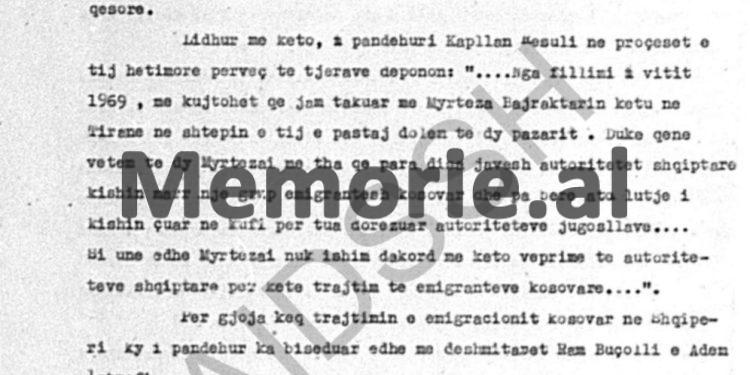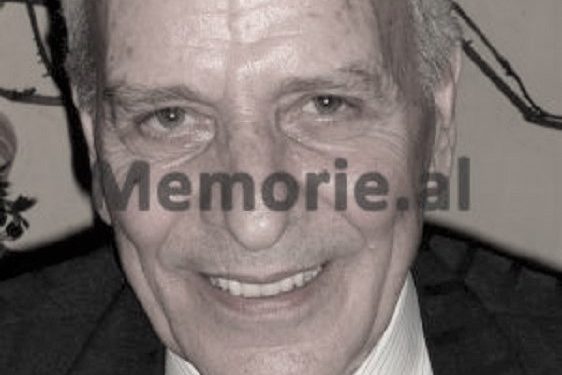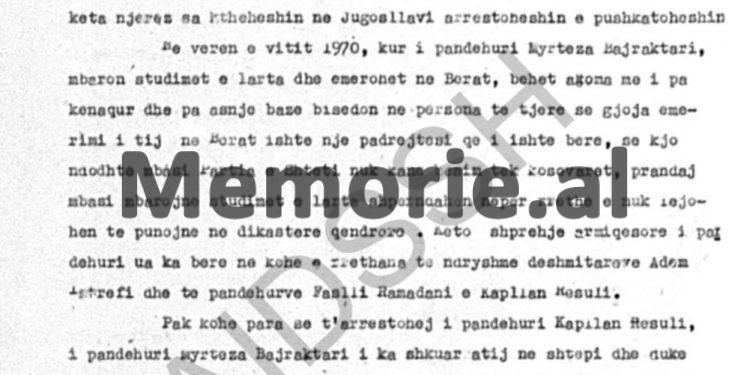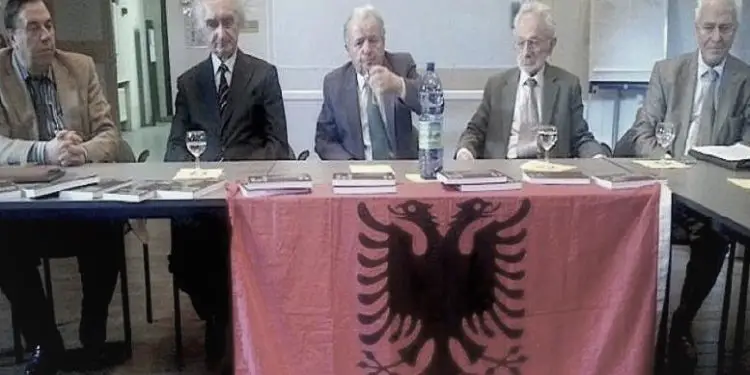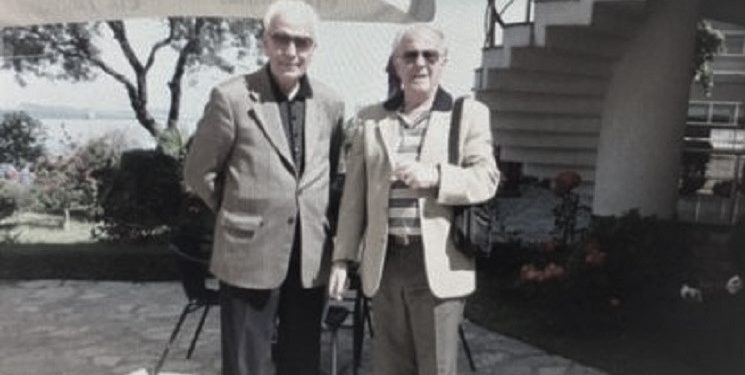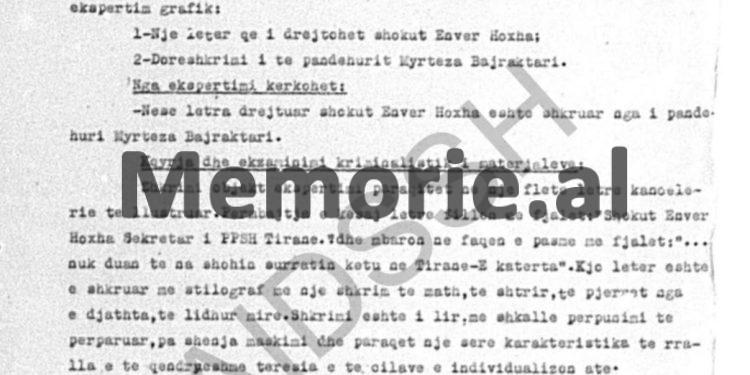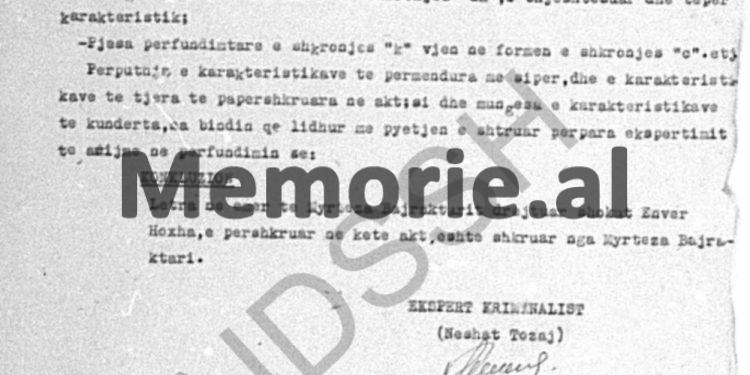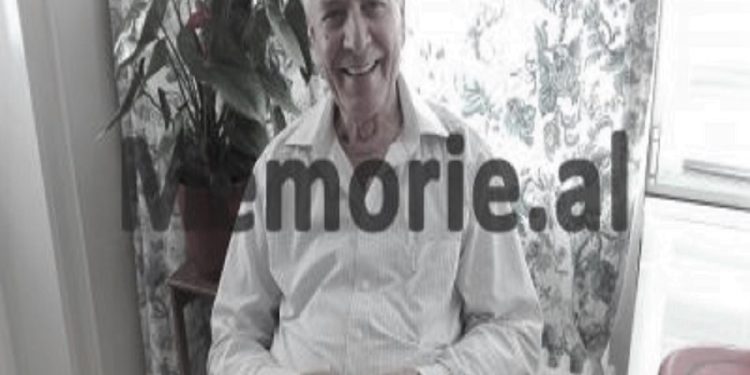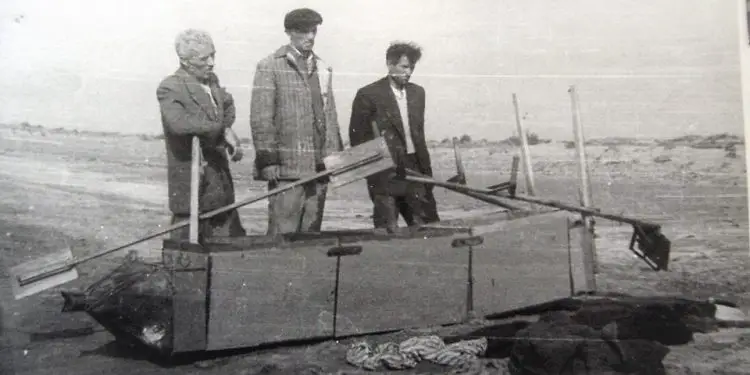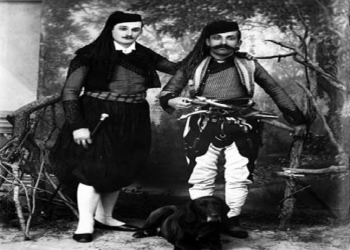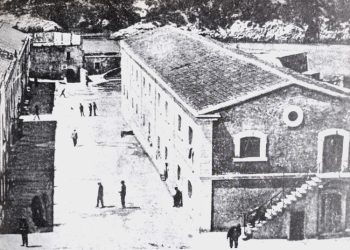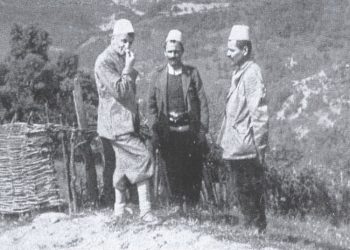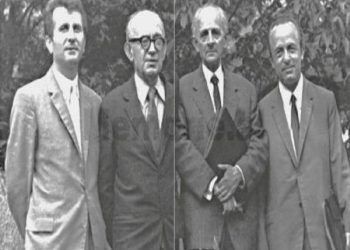Dashnor Kaloçi
Part sixteen
Memorie.al/ publishes some archival documents issued by the institution of the Authority for Information of Former State Security Files, where is the voluminous file (forms, investigative and judicial), of Myrteza Bajraktari originating from Gostivar, who after finishing school high school in the city of Tetovo, in 1952, began his higher studies at the University of Skopje, in the branch of Philosophy, where in addition to teaching he was employed as a journalist in the newspaper “Flaka e Vllaznimit” published in Skopje, from where he was fired soon after, he published an article where he was openly against the displacement of Yugoslav Albanians to Turkey and as a result, he was appointed as a teacher in the 7-year school “Shaban Zeneli” in Kumanovo. Myrtezai was arrested by the UDB in 1952, after he was part of a secret organization called the ‘Albanian National-Democratic Organization’, and he was sentenced to seven years in political prison, which he served in the Nis prison and Idrizovo. Escape from Yugoslavia and coming to Albania, where after staying for some time in the internment camp in Seman of Fier, he was given the right to high school, graduating from the University of Tirana in Language and Literature, but after refusing the appointment in the city of Berat, in 1971, he was arrested and sentenced to seven years in political prison, on charges of “agitation and propaganda”. Release from prison and leaving without work until the collapse of the communist regime and his appointment as Consul General of Albania in Switzerland, until 1993, and then his election as Honorary President of the Albanian League in the World, for the countries of Benelux, where he worked for the cause of Kosovo, until he passed away on December 11, 2020. The entire complete file of Myrteza Bajraktari, with the names of officials and officers of the State Security, the nicknames of collaborators, “colleagues” and The “compatriots” who followed and monitored him, the provocateurs in the investigation cells, the witnesses who appeared in court, the letters sent to Enver Hoxha and the high official instances where he demanded his innocence, etc., etc., are published for the first time by Memorie .al
Continued from the previous issue
The document with the indictment against the defendant Myrteza Bajraktari, drafted by the Prosecutor of the Tirana District, Asaf Kondi, sent for trial to the People’s Court of the Tirana District
THE PEOPLE’S REPUBLIC OF ALBANIA
DISTRICT PROSECUTOR’S OFFICE Tirana, on 5.1.1971
Section IV
No. 500 Prot.
POPULAR COURT OF TIRANA DISTRICT
T I R A N Ë
Attached we are sending you for trial the case of the defendant Myrteza Bajraktari, accused under Article 73 of the Code of Criminal Procedure of R.P.Sh.
For its secret character, we demand that the trial against him take place behind closed doors.
DISTRICT PROSECUTOR
Asaf Kondi
APPROVED
Tirana District Prosecutor
Asaf Kondi
ACT – ACCUSATION
Against the defendant Myrteza Bajraktari, accused of committing the crime of agitation and propaganda against the popular power provided in Article 73/1 of the Criminal Code.
The State Security organs, with the sanction of the General Prosecutor, on November 12, 1970, arrested the defendant Myrteza Bajraktari, after starting from the day of his arrest, molded with bourgeois and nationalist ideology; he made agitation and propaganda against the popular power. , in different directions.
From the investigation, it results:
The defendant Myrteza Bajraktari with a nationalist point of view and an opponent of the socialist system, starting from 1963-1964, demands that in the People’s Republic of Albania, he be treated as a privileged person, unlike all Kosovar emigrants who were here.
He stated that allegedly, the Party and the People’s Power mistreated Kosovars in Albania and were not interested in the rights of the Kosovar people. Over time, the defendant Myrteza Bajraktari, delves deeper into these thoughts and, says low expressions, in the direction of the partisan forces that during the war went to the aid of the Kosovar people.
Witness Xhevair Hasa, in this regard, said: “Myrtezai told me that I came to Albania to help for the liberation of Kosovo and they immediately deported me and do not help the Kosovar people.
He emphasized that: the Albanian partisan brigades that came to Kosovo did not liberate us, but in cooperation with the Yugoslav brigades, enslaved us. “During his stay in Seman, and after establishing full trust in the witness Xhevair Hasa, the defendant Myrteza Bajraktari of speaks openly to him, against the Party and the People’s Power.
Regarding this, this witness says: “During the conversations we had at that time with Myrtezai, he told me that: the communist regime in Albania is vile and that it keeps this people under the rule of force. Likewise for the youth, he said that she has no kind of amusement. ”
From 1965, defendant Myrteza Bajraktari urged witness Xhevair Hasa to pray for his return to Yugoslavia. After Xhevairi made the prayer, Myrtezai instructed him that when he went there, to tell some of the defendant’s acquaintances that the latter was allegedly suffering in exile in Albania and that they should be interested in his withdrawal from Albania to Turkey. .
For the realization of these orders, the defendant Myrteza Bajraktari, gave Xhevair and some identification slogans. This defendant molded with these thoughts and views at the end of 1965 prays to go to Turkey. When witness Halit Llazana advises him to withdraw this prayer, the defendant tells him: “Better to end up as a vagabond in Turkey than to suffer in Albania.”
In 1966, defendants with state scholarships were given the right to continue their higher studies at the State University of Tirana. During this time the defendant instead of giving up this activity, added to it, making conversations of a hostile nature.
Regarding these, the defendant Kapllan Resuli, among other things, testifies: “At the beginning of 1969, I met with Myrteza Bajraktari at his house and then we both went shopping. He told me that a few weeks ago the Albanian authorities had received “A group of Kosovars, without praying, handed them over at the border to the Yugoslav authorities. Like me and Myrtezai, we did not agree with this treatment of Kosovars.”
He had talked to witnesses Ram Buçolli and Adem Istrefi about the alleged mistreatment of Kosovar emigrants in Albania. Thus, for example, the witness Adem Istrefi explains: “From the bad treatment we were given in Seman, said Myrtezai, I went crazy and the friend with whom I had come from Yugoslavia. Take it easy, Myrtezai emphasized, how it was hard for his family, his return from Albania in that condition “.
The defendant Myrteza Bajraktari, slanders and fabricates in the direction of the principled political line that our Party has followed and continues to follow on the issue of Kosovo. Thus, in a conversation that the defendant had with the witness Ram Buçolli, he told him that allegedly Albania has never been interested in the liberation of Kosovo.
Allegedly, the Albanian government before 1948, denounced to the Yugoslav government all Kosovars who came to Albania and told about the crimes committed by the Yugoslavs. And as a result of all this, they surrendered to the Yugoslavs who imprisoned or shot them.
In the summer of 1970, when the defendant Myrteza Bajraktari graduated and was assigned to Berat, he further aggravated his anger against the Party by talking to various people and telling them that his alleged appointment to Berat did not was right, as Enver Hoxha’s regime did not trust Kosovars and appointed them to different districts, not allowing them to work in central departments.
The defendant made these hostile expressions at different times and circumstances to the witness Adem Istrefi and the defendants Faslli Ramadani and Kapllan Resuli. Shortly before the arrest of the defendant Kapllan Resuli, the defendant Myrteza Bajraktari went to his house and during a conversation Kapllani told him to read the so-called “statute program of the National Liberation Front of Kosovo”.
The purpose of this program was to raise Kosovars against the People’s Power Party in Albania. Defendant Myrteza, gets acquainted with the content of this material, by reading it. Although the defendant Myrteza Bajraktari has not pleaded guilty, his hostile activity is fully proven by the statements of witnesses: Xhevair Hasa, Ram Buçolli, Adem Istrefi, Halit Llazana, and by the depositions of the defendants, Faslli Ramadani and Kapllan Resuli.
Based on the above:
Defendant Myrteza Bajraktari, son of Fahri and Remzija, born in 1933, born in Gostivar, Yugoslavia, and resident in Tirana, with higher education, married, with one child, without party, unpunished, with nationality and citizenship Albanian, of social origin, middle citizen, arrested on 12 November 1970.
CHARGED THAT:
He has developed agitation and propaganda against the popular power, a crime provided by Article 73/1 of the Criminal Code. Pursuant to Article 204 of the Code of Criminal Procedure, Act – Prosecution together with the investigative file no. 15270, to be forwarded to the Prosecution for trial of the defendant Myrteza Bajraktari.
Act – The indictment was compiled in the city of Tirana. dated 10.4.1971.
Investigator Elham Gjika
Act I received the Indictment on 4.5.1971
Defendant Myrteza Bajraktari
The document with the decision of the investigator of the Directorate of Internal Affairs of Tirana, Elham Gjika, for sending a letter of Myrteza Bajraktari, sent to Enver Hoxha, for graphic expertise at the Central Forensic Laboratory
DECISION
“ON THE APPOINTMENT OF GRAPHIC EXPERT”
In Tirana, on February 15, 1971. I, the investigator of the Directorate of Internal Affairs of Tirana, after studying the materials in charge of the defendant Myrteza Bajraktari.
I realized:
During the search of the defendant’s apartment, a letter was found in his correspondence, which begins with the words “Secretary of the Albanian Labor Party” and ends with the words “Fourth”. It is a sheet written on two pages in pelican ink.
Considering the importance of this material for the case and to prove that it was written by the defendant Myrteza Bajraktari, conform article 167 -168 of the Code of Criminal Procedure
DECISION
To send the above letter, together with the manuscripts of this defendant, which begins with the words: “My name is Myrteza Bjraktari” and ends with the words: “I finished my studies in 1970”, to the Central Forensic Laboratory, for graphic expertise.
Before the expert, ask the question:
If the letter was written by the defendant Myrteza Bajraktari.
Investigator
ELHAM GJIKA
The document with the graphic expertise of the letter of Myrteza Bajraktari, sent to Enver Hoxha, drafted by the forensic expert, Neshat Tozaj, of the Central Forensic Laboratory of the Ministry of Internal Affairs
THE PEOPLE’S REPUBLIC OF ALBANIA
MINISTRY OF INTERNAL AFFAIRS
CENTRAL CRIMINAL LABORATORY
Tirana, on 17.2.1971
A K T No. 31
(Graphic handwriting expertise)
From the Investigation branch of the Ministry of Internal Affairs, with a decision, dated 15.2.1971, of the investigator Elham Gjika, was sent to us for graphic expertise.
- A letter sent to Comrade Enver Hoxha.
- Defendant’s Manuscript, Myrteza Bajraktari.
Expertise requires:
If the letter sent to Comrade Enver Hoxha was written by the defendant Myrteza Bajraktari.
Forensic examination and examination of materials:
The writing, object of expertise, is presented on a sheet of illustrated office paper. The content of this letter begins with the words: “Comrade Enver Hoxha, First Secretary of the Central Committee of P.P.SH, Tirana”, and ends with the words: “they do not want to see our muzzle here in Tirana, – The fourth”.
This letter is written in font with a large, outstretched, sloping writing, from the left, well connected. The writing is free, with advanced processing scale, no masking marks and presents a scale of rare and enduring features, the totality of which individualizes it.
Myrteza Bajraktari’s writing patterns were taken on white paper, written with a fountain pen, in free writing, unmasked. This manuscript was taken in the presence of the investigator of the case, who made the relevant certification at the end of the letter.
This article is valuable to use in the quality of comparative material on this subject.
From the study were extracted the general and special characteristics for the letter and the writing model of Myrteza Bajraktari and from their comparison, it results that they are completely compatible, both with the general and special signs, which consist in the construction of the elements of which the letter received.
Below, we are prescribing, the special features that are most typical for this writing:
- Fusion without detaching the hand in the construction and connection of the letters.
- The construction has the characteristics of the letter “q”.
- Start at the top right of the oval in the letters “q” and “ë”.
- The final part of the letter “k” comes in the form of the letter “ç”.
Consistency of the characteristics mentioned above and others, not described in the act, as well as the lack of opposite characteristics regarding the question posed before the expertise, to conclude that:
Conclusion
The letter on behalf of Myrteza Bajraktari, addressed to Comrade Enver Hoxha, described in this act, was written by Myrteza Bajraktari himself. Memorie.al
Forensic experts
Neshat Tozaj
The next issue follows




